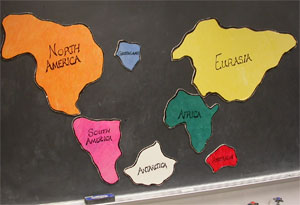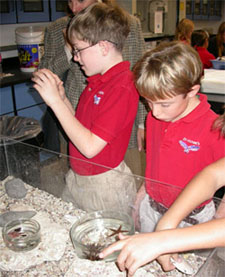- Join our exploration of marine life of the Gulf of California at the Marine Discovery Lab at the University of Arizona. Read more about the Marine Discovery Lab field trip.
- Visit the lab stations and view movies of 5th grade students engaged in hands-on laboratory activities led by UA undergraduates:
Shark Dissection Lab Station
Students are led through the dissection of a dogfish (Squalus), with an emphasis on body form and function, and adaptations to the marine environment.
Questions and Big Ideas
Using a preserved shark (Spiny Dogfish) students address the following questions and issues:
- How has the shark adapted to its environment?
- Where is the shark found? What does it eat? How does it swim? What is its prey? What preys on it? How does it reproduce?
- What is the external and internal anatomy of a shark?
- How are sharks similar to and different from bony fish?
- Why are Spiny Dogfish caught by humans? What are some of the impacts of over fishing?
- How big was the fossil shark Megalodon, based on the size of its teeth?
Squid Dissection Lab Station
Students dissect a squid (Loligo spp.), and focus on its special adaptations.
Questions and Big Ideas
Using preserved squid students do a dissection and learn:
- How has the squid adapted to its environment?
- Where is it found? What does it eat? How does it swim? What is its prey? What preys on it?
- How does it reproduce?
- What is the external and internal anatomy of the squid?
- Why are squid caught by humans?
Fish Diversity Lab Station
Questions and Big Ideas
Using preserved fish students explore the following ideas and questions:
Marine Fossils Lab Station
Students are led through a discussion of how fossils are formed and what they can tell us about the past. They examine fossils, and construct a model of Pangaea. Students assemble a time line depicting the development of life. Emphasis is placed on understanding plate tectonics, geologic time and the mechanisms that create fossils.
Questions and Big Ideas
In this lab students learn:
- What are fossils?
- What kinds of animals can become fossilized?
- How are fossils created?
- What do marine fossils found near Tucson tell us about Tucson’s past environment?
- What is continental drift and what is the evidence for it? What are plate tectonics?
- How was the super continent Pangaea formed?
- Geological Timeline – when were the major events in earth’s history?
Rocky Intertidal Zone Lab Station
Students learn about the unique environment of the rocky intertidal zone and its special inhabitants, with an emphasis on the adaptations necessary for life in the zone between land and sea. Everything from echinoderms to chordates to some new creatures you may never have heard of are represented!
Questions and Big Ideas
Using live animals (sea cucumbers, sea urchins, snails, hermit crabs, brittle stars, and sea stars) from the intertidal zone students explore the following ideas and questions:
- What defines the intertidal zone?
- How are tides created?
- How do these animals eat?
- How do these animals protect themselves from life in the intertidal zone? (Answers: drying out, crashing waves, changes in temperature, being eaten by other animals).
- How are stresses imposed by man affecting the animals living in the intertidal zone?
- What phylum are each of these animals in?
- How are animals in different phyla are similar and different?











 Go to quick links
Go to quick search
Go to navigation for this section of the ToL site
Go to detailed links for the ToL site
Go to quick links
Go to quick search
Go to navigation for this section of the ToL site
Go to detailed links for the ToL site